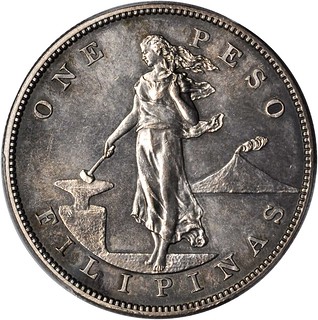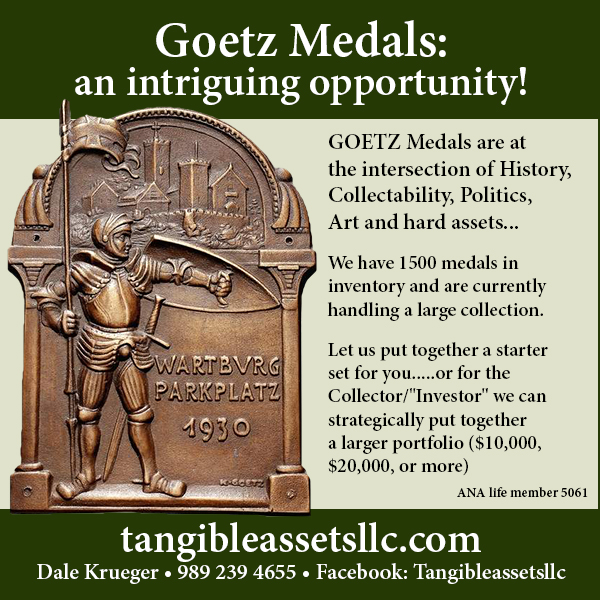
PREV ARTICLE
NEXT ARTICLE
FULL ISSUE
PREV FULL ISSUE
READER THOUGHTS ON OBVERSE AND REVERSELast week we kicked off a discussion of how to define the obverse and reverse of a coin. -Editor   Martin Purdy of Upper Hutt, New Zealand writes: Telling obverse from reverse should be easy in theory - just find out which design was on the lower die and that's the obverse, the upper die being the reverse! But then, getting that info out of all the world's mints isn't going to be all that straightforward, and I'm sure I've seen a video of certain coins being struck sideways, which does away with any notion of upper and lower in those cases anyway. It really does vary from series to series. In any monarchical system with a royal effigy on one side, it's easy because that's going to be the obverse. But (there's always a but), the principle with NZ-issued tokens is that the name of the issuer appears on the obverse, so in instances where the issuers included an image of the Queen or Prince Albert on their tokens, the royal image is actually the reverse (the logic being these aren't regal coinage and therefore not issued in the name of the Queen, so the royal image is secondary to the name of the issuer). And in the Japanese series, the definition of which side was obverse and which was reverse was swapped over in 1875, in mid-series, with no change in design. I have never found out why. Maybe they swapped the position of the upper and lower dies? So, all flippancy aside, each issuing entity seems to have its own principles. I recently read a series of articles in Ursula Kampmann's CoinsWeekly on German circulating coins, and the attribution of obverse and reverse accompanying the photos was the opposite of what I had been assuming for the previous 45 years or so. Never too late to learn, I guess. John Phipps writes: I think the obverse/reverse question just scratches the surface of USPI coin questions. In 2015, I was a first time exhibitor at the ANA World's Fair of Money Show. My exhibit was about the confusion associated with the 1936 Commemorative Issues. The starting premise was that as I looked for these coins at shows, many dealers would offer 1947 MacArthur commemorative coins or 1920 Wilson Mint Opening medals. As I worked on the exhibit I found much more confusion! My first struggle was which class to mark on the exhibit application. Should it be in "Class 1: US Coins" or "Class 14: Numismatics of Asia & the Pacific." The best suggestion I got on that question was to enter the exhibit in Class 14 because there would be fewer entries and a better chance of being recognized with an award. The second questions was which side is the obverse and the reverse? This is important as the ANA judges are taught to be critical and "errors" reduce the points awarded to the exhibit. I consulted a number of books and even called two noted Philippine numismatists on the phone. I found four very unclear answers, 1) "the obverse is the side with the human image," 2) "the obverse is the side with the date," 3) "the reverse is the side with the denomination" and 4) "the obverse is the side that the hammer die strikes." One and three are in conflict with two and I never did figure out which "side the hammer die struck." So I added some text to my exhibit on this confusion. The third question was whether the "Mint of the Philippine Islands" is a branch of the US Mint or not? Most written reference sources say that it was a branch mint. But the facts make a very strong and clear case that this mint was not a branch mint. In my investigation of this question I also asked why USPI coins are not included in "Major US Type Set" albums and folders. The clearest answer I got on that was from Ken Bressett. He said, "We just don't think of those coins that way." I don't think that these questions ever will have universally accepted answers. But my exhibit got Third Place in Class 14 so I was very happy to have this confusion in the hobby. Great questions often lead only to more questions. Interesting topic! I wasn't aware of the tie to the die. Where did that tradition start? -Editor Martin adds: There's a variant on "heads or tails" that uses "cross or pile" instead - the cross being the standard reverse on most European silver pennies/deniers in the Middle Ages, and pile being the name for the fixed lower die. That makes the upper die, or trussel - the one that was hit with the hammer in those days - the reverse, which conflicts with Mr. Phipps' fourth definition. Even these definitions become muddled, depending on which source you read, and the French say "pile ou face", in which "pile" is the upper die or the reverse ... Here's Brewer on the subject - I'd love to know the source for the swapping of terminology that he mentions, but it at least explains the difference in the use of "pile" between English and French: Cross or pile. Heads or tails. The French say pile ou face. The "face" or cross was the obverse of the coin, the "pile" was the reverse; but at a later period the cross was transferred to the reverse, as in our florins, and the obverse bore a "head" or "poll." Clearly a minefield! I don't think we'll ever get a universal definition in these largely post-monarchical days. Thanks, everyone! -Editor To read the earlier E-Sylum article, see:
 Wayne Homren, Editor The Numismatic Bibliomania Society is a non-profit organization promoting numismatic literature. See our web site at coinbooks.org. To submit items for publication in The E-Sylum, write to the Editor at this address: whomren@gmail.com To subscribe go to: https://my.binhost.com/lists/listinfo/esylum All Rights Reserved. NBS Home Page Contact the NBS webmaster 
|